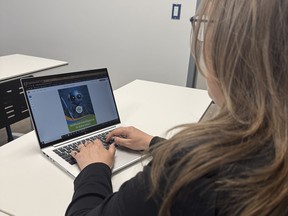
Article content
Grand Erie is among just a few school boards in Ontario to create a policy and guidelines related to the use of artificial intelligence (AI) in classrooms.
Advertisement 2
Article content
People have diverse opinions on AI and, depending on who you ask, said Lynn Thomas, the board’s teacher consultant for e-learning, they’re excited, concerned or ambivalent about its potential.
Article content
Recommended Videos
Article content
“AI is fairly new in the education sector,” said Lisa Munro superintendent of curriculum and student achievement and creator of the AI policy approved by the school board earlier this month. “As a district, we’re excited about our proactive approach to establishing structures in our organization that support the use of AI to grow imagination, creativity and efficiencies.”
Thomas believes children should start learning about AI at a young age to better understand its risks – deepfakes (images, videos or audio that have been edited or generated using AI) and disinformation, environmental and social impacts and algorithmic bias.
Advertisement 3
Article content
“Teaching about AI should be embedded in the system,” said Thomas, who authored the board’s AI guidelines. “Those critical thinking skills must be built throughout the school career, not just when you turn 18. You don’t instantly know how to use AI in an ethical and safe way.”
“(The school board’s policy and guidelines) help students navigate an AI world and to critically analyze and think about how they’re using it and how others are using it.”
A study released by KPMG last October indicates six in 10, or 59 per cent, of Canadian students now use generative artificial intelligence in their schoolwork. While most say the tools have improved the quality of their assignments and helped them with exams, two thirds admit they’re not learning or retaining as much knowledge.
Advertisement 4
Article content
“Educators should consider what the ramifications will be for this generation who, while adept at using technology, might not be developing the critical-thinking skills they need to lead successful lives and careers,” said C.J. James, partner and national education practice leader for KPMG.
AI has the potential to be an effective tutor, and create immersive learning experiences for students through, for example, virtual reality that can simulate real-world scenarios and complex concepts. Students can explore historical sites, conduct virtual science experiments or practise language skills with AI-driven avatars. Many Grand Erie students use Canva, an AI-powered graphic design platform, to create images and slideshows.
Advertisement 5
Article content
While ChatGPT, the most well-known, GenAI tool, offers limited access to users under the age of 18, students in K-12 classrooms can experiment with similar large language models like Byte and PeopleAI.app, said Thomas.
“PeopleAI is populated with information about hundreds of historical figures,” she said. ”You could talk to Elvis or Nelson Mandela.”
But educators – and parents — worry about possible cheating with AI apps, which can generate essays and research papers on command.
Thomas said that while plagiarism can often be easily detected, there have also been well-publicized cases of AI detectors not being very dependable and wrongly accusing students of cheating.
Thomas shares tips and tricks with educators for spotting AI-generated content. She also promotes ways to tweak assignments to make them “less AI-able.” Teachers can ask students to write an essay about how they personally connected with a book they read, for example, something AI can’t produce.
Advertisement 6
Article content
AI can also be a benefit for educators and non-teaching staff.
By automating administrative tasks, AI lets staff spend more time on teaching and student interaction. They can also use AI to customize educational content, such as lesson plans, quizzes and rubrics – in any language for any level.
“If you’ve got a class of Grade 8s with reading levels from Grade 3 to 10, you can have AI create text at five different grade levels,” said Thomas. “That’s kind of a game changer.”
But Thomas and Munro said AI “can never replace an educator’s soft skills and professional judgement.”
“The human in the room is still the most important teacher.”
Article content